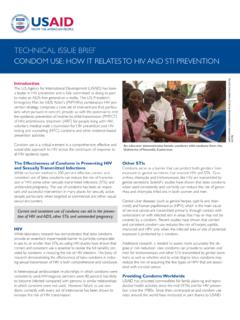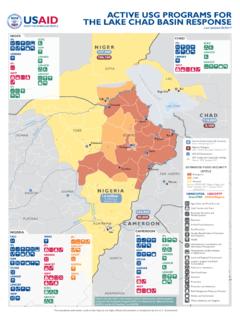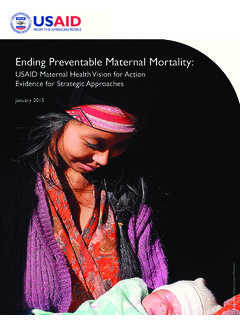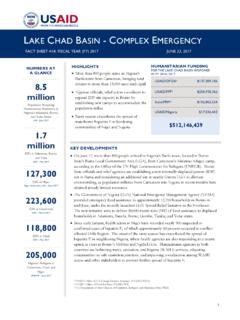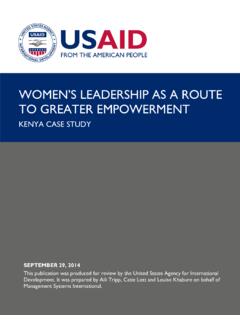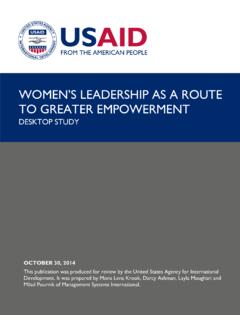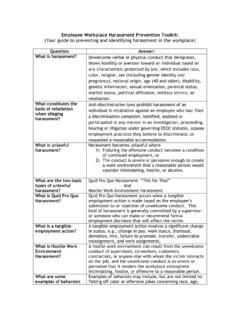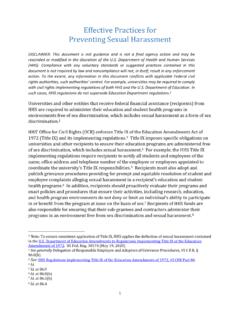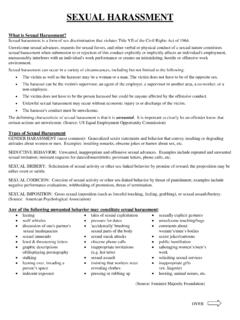Transcription of PART 2: GBV DEFINITION, PREVALENCE, AND GLOBAL …
1 Toolkit for Integrating GBV prevention and Response into Economic Growth Projects 3 PART 2: GBV DEFINITION, PREVALENCE, AND GLOBAL STATISTICS Defining GBV and showing its prevalence through GLOBAL statistics raise vital awareness about several important issues: what it is and how to recognize it; the scope of the problem; whom it affects; how it affects workers and workplace productivity; and its costs to households and nations. Knowing what constitutes work-related GBV and the urgency of the problem can help economic growth project implementers, employers, managers, and workers advocate for reducing GBV and increase accountability for safer, more productive workplaces and communities. In the world of work, multiple types of GBV significantly affect individuals and workplaces, as well as wider economic development objectives. Specific forms of GBV that impact workers and the workplace include: Domestic and IPV Gender-based workplace discrimination , stigmatization, and social exclusion Sexual harassment and intimidation Sexual exploitation and abuse Trafficking for forced labor and sex work within and across borders.
2 According to the International Labor Organization (ILO 2011), high-risk groups comprise workers in formal and informal economies and include: Office and factory workers Day laborers Dependent family workers Women farmers GOVERNMENT S DEFINITION OF GBV Violence that is directed at an individual based on his or her biological sex, gender identity, or perceived adherence to socially defined norms of masculinity and femininity. It includes physical, sexual, and psychological abuse; threats; coercion; arbitrary deprivation of liberty; and economic deprivation, whether occurring in public or private life. GBV takes on many forms and can occur throughout the life cycle. Types of gender-based violence can include female infanticide; child sexual abuse; sex trafficking and forced labor; sexual coercion and abuse; neglect; domestic violence; elder abuse; and harmful traditional practices such as early and forced marriage, honor killings, and female genital mutilation/cutting.
3 Both Women and Men Experience GBV Women and girls are the most at risk and most affected by GBV. Consequently, the terms violence against women and gender-based violence are often used interchangeably. But boys and men can also experience GBV, as can sexual and gender minorities. Regardless of the target, GBV is rooted in structural inequalities between men and women and is characterized by the use and abuse of physical, emotional, or financial power and control. Source: 2012. United States Strategy to Prevent and Respond to Gender-based Violence Globally. Washington, DC. Toolkit for Integrating GBV prevention and Response into Economic Growth Projects 4 Child laborers Forced and bonded laborers Migrant workers Domestic workers Health services workers Sex workers. Women are often overrepresented in temporary, lower paying, and lower status jobs with little decision-making or bargaining power over the terms and conditions of their labor.
4 Risks of work-related GBV may be higher in low-wage industries where women workers predominate and hold few managerial positions, such as certain agricultural commodities or garment production. Lack of bargaining power and labor policies leave millions of workers, particularly women, unprotected and without recourse in the face of gender-based discrimination and workplace violence. Further, workers who do not conform to stereotypical social norms for what a man or a woman should be or do for their livelihood, or who practice diverse gendered behaviors, can become targets of work-related discrimination , stigma, harassment , exploitation, and abuse. In conflict and crisis-affected contexts, forcibly displaced persons including internally displaced persons (IDP), refugees, and those affected by disasters, famine, or political crisis face existing and increased risks of GBV in their efforts to earn a living.
5 A 2011 United Nations High Commission for Refugees (2011) study of IDP camps in Haiti found that women in all five camps were exploited sexually to obtain cash for basic necessities such as food. Transactional sex in situations of crisis and deprivation constitutes a form of economic, psychological, physical, and sexual GBV. IDP attempting to return to previously crisis-affected areas for recovery and longer-term development may also be at heightened risks of GBV in all spheres of life, including at work. PREVALENCE AND GBV STATISTICS The GLOBAL prevalence of GBV is staggering. Women are affected disproportionately. Available statistics at national, multinational, and GLOBAL levels set the context and make a compelling case that cannot be ignored. Economic growth projects must work to prevent and respond to GBV to ensure that it does not undermine economic outcomes and human development. Toolkit for Integrating GBV prevention and Response into Economic Growth Projects 5 Available evidence shows that IPV and non-partner sexual violence are highly prevalent and documented forms of GBV that women face around the world.
6 IPV and non-partner sexual violence affect workers, workplaces and productivity outside the home, through lost days of work, lost wages, medical expenses, and pain and suffering. Because of the widespread prevalence of IPV and of non-partner sexual violence, and their effects on workers and workplace productivity, several case examples and references in the Toolkit relate to forms of IPV or non-partner sexual violence, specifically against women. While IPV and non-partner sexual violence prevalence are broadly documented, all forms of GBV remain under-researched in and outside of the world of work. Sexual harassment is a widespread form of workplace GBV, and yet substantial information gaps persist across industries and countries. GBV PREVALENCE: GLOBAL AND NATIONAL STATISTICS According to the World Health Organization (WHO), 35 percent of women worldwide have experienced either physical and/or sexual IPV or non-partner sexual violence (WHO 2013).
7 Violence studies from 86 countries across WHO regions of Africa, the Americas, Eastern Mediterranean, Europe, South-East Asia and the Western Pacific, show that up to 68 percent of women have experienced physical and/or sexual violence in their lifetime from an intimate partner (ibid., p. 44). The highest prevalence rates were found in central sub-Saharan Africa, with an estimated up to 66 percent of ever-partnered women having experienced physical and/or sexual violence by an intimate partner (ibid.). GBV is a major cause of disability and death for women aged 15 44 years (United Nations Women 2011). Globally, one out of every five women will become a victim of rape or attempted rape over the course of her lifetime (Heise, Ellsberg, and Gottemoeller 1999). Between 20,000 and 50,000 women in Bosnia-Herzegovina were raped during the 1992 1995 war (UNIFEM 2002). During the 1994 Rwandan genocide, an estimated 250,000 500,000 women were raped (UN 1996).
8 In 2009, men represented 24 percent of trafficking victims detected globally (United Nations Office on Drugs and Crime 2012). In 2012, women and girls represented 55 percent of the estimated million victims of forced labor worldwide, and 98 percent of the estimated million forced into sexual exploitation (ILO 2012). FORMS OF IPV AND NON-PARTNER SEXUAL VIOLENCE ALL AFFECT THE WORLD OF WORK IPV refers to any behavior within an intimate relationship that causes physical, psychological, or sexual harm to those in the relationship. Non-partner sexual violence refers to any experience of being forced to perform any sexual act that a person did not want to by someone other than his or her partner. All forms of IPV and non-partner sexual violence affect workers and can take place within the workplace. One of the most prevalent forms in the workplace is sexual harassment . Examples of IPV and non-partner sexual violence that affect the world of work include: Emotional (psychological) abuse, such as sexual harassment , insults, belittling, constant humiliation, intimidation ( , destroying things), threats of harm, or threats to take away children; Controlling behaviors, including isolating a person from family and friends; monitoring their movements; and restricting access to financial resources, employment, education, or medical care; Acts of physical violence, such as slapping, hitting, kicking, and beating; Sexual violence, including forced sexual intercourse and other forms of sexual coercion.
9 Toolkit for Integrating GBV prevention and Response into Economic Growth Projects 6 Documentation of GBV in the workplace against men remains an under-researched area as well, and an information gap. Data gaps must be addressed on gender-based labor discrimination , stigma, harassment , intimidation, exploitation and abuse, and labor and sex trafficking. More research is needed on all forms of GBV that affect work and the workplace. Recent research and documentation of workplace GBV against women are as eye opening as GLOBAL GBV prevalence statistics, which show that women are disproportionately affected. In 2011, the Palestinian Central Bureau of Statistics worked in partnership with the International Labor Organization (ILO) and the Institute of Women Studies at Birzeit University to conduct a survey in the occupied Palestinian territory on GBV in the workplace. The study focused on three types of workplace violence: Gender harassment , Unwanted sexual attention, and Sexual coercion.
10 The survey found that victims of workplace GBV were predominantly young women. Of the 853 women who responded to the survey, 29 percent of those aged 25 29, and 18 percent of those aged 24 and under, reported having experienced one or more of the three forms of violence at work over the previous 12 months. A further 32 percent of women aged 30 40 interviewed also said they had experienced one or more forms of workplace GBV in the last year. Women of all ages are at risk of GBV in the workplace, whether because of the nature of their jobs or overall social status in society. Sexual harassment and other forms of harassment are serious forms of discrimination across the world that undermine the dignity of women and men, negate gender equality, and can have significant implications. Gender-based violence in the workplace should be prohibited; policies, programme, legislation and other measures, as appropriate, should be implemented to prevent it.
